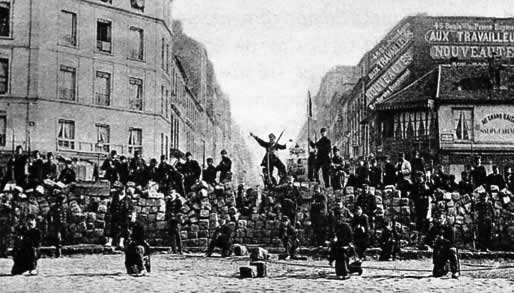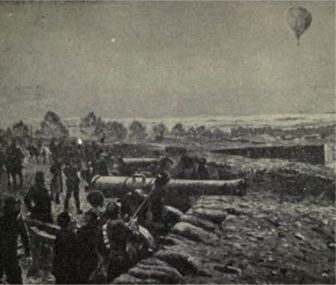France During the Crash
Part 2
Paris was in chaos. The attempted arrest of Louis-Auguste Blanqui had set off the ticking time-bomb of social tension, which was now running rampant through the streets. The police could do nothing but escape the city, and most of the Parisian National Guard had joined the revolters. Looting was excessive, and anarchy was the feeling of the day. But the most important question on Paris's mind however was, "Where is Blanqui?"
He was organizing. On April 22nd, he appeared with a large group of followers at the Place de la Bastille, all touting Red flags and red armbands. As people noticed the scene, they stopped, and looked toward him, as he climbed on to the monument that commemorated the storming of the prison almost nine decades before. As people stared at him looking across the open square, he began to speak. And the Parisians gathered and listened.
"Parisians, you stand now on the birthplace of the French Republic. Generations ago, our great-grandfathers and mothers stood here to bring liberty, equality, and fraternity to the French people. They bravely stormed this embodiment of oppression, the old regime of Kings and Queens. And now, the regime of old, the regime of the Grand Napoleons, holds the people hostage. They hold us, and our potential as a society in chains.
But no more! The city of Paris has removed the chains. We have thrown off the bonds of the oppressors on all sides. The worker of Paris is freed from his boss's shackles. The thinker freed from his government's injustice....
...My comrades, how hard did you work for your wage? For your Boss?
And how much did it matter? Did he save you from The Crash?
NO! He let you slide into poverty, let your family slide into hunger and disease.
And, my comrades, what did your government do? Did they feed you? No. They did not. They stood there, behind the money and gold that they had made from the sweat and blood of the worker's hands.
Enough is enough my brothers! The time to finally come to join our ancestors and embrace our potential as a society of equals. Throw off the chains, and join me in Revolution! Long live the Worker! Long live the Republic!"
It was shorter than most of his speeches. But it was effective. The moment his speech ended, the eruption from the crowd, which by this point swelled to almost 10,000 people, roared with approval, and a chorus of "La Marseillaise[FONT=Arial, sans-serif]"[/FONT] moved through the square. In only a few minutes, Blanqui had brought Paris under his control.
Meanwhile, Napoleon IV had moved to Versailles to escape the violence that had engulfed his beloved capitol. He was deeply worried about Paris, seeing that onl days after his being crowned, the largest and grandest city in his Empire had revolted against him. He was determined that it would be the last, and ordered the army under General MacMahon, who had been encamped at Versailles for the last few days, was told to move to a town called Sevres, which was about halfway between Versailles and Paris. In Paris itself, order had been restored, and the National Guard units who revolted with the Socialists were now organizing into a real military force. Barricades began to be put up on many of the major avenues in Paris, and thousands of eager workers joined the Guards ranks. However, Blanqui, now the supreme authority in Paris, was not interested in defensive action. Versailles, he thought, needed to be taken if the revolution was to be taken seriously.
The Socialist military meetings ended with an offensive plan to finally spread the revolution to all of Metropolitan France. Reports had been coming in from sympathizers that the Army of Versailles was camped in Sevres, near a vital bridge over the Seine. Just to the north of Sevres was St. Cloud, another small suburb which stood near another bridge of importance. The Socialist offensive consisted of a flanking maneuver, advancing over the bridge at St. Cloud and attacking the Army of Versailles from the left, while a smaller force engaged them from the front. Hopefully this would succeed in surprising them and routing them all the way back to Versailles.

The Socialist Army marches toward Sevres; May 5th, 1875
On May 5st, the Socialist force, of about 50,000 men, almost half being workers who had little to no experience with a firearm, marched toward the St. Cloud bridge under the command of Jarosław Dąbrowski, an immigrant from Poland who had been caught up in the revolutionary fervor. [FONT=verdana, sans-serif]The next day, on the 6th, shelling began from the Socialist force directly in front of the Army of Versailles, succeeding in capturing their attention. The back and forth shelling brought minor casualties on both sides, but it was a wake up call. Neither party was backing down. At about 4 P.M. on the 6th, the Socialist main force made itself known, as some rearguard Loyalist forces who were positioned on the road from St. Cloud. They quickly notified the main Loyalist force, who swung their attention to the left, where some 50,000 Socialists were beginning to lay down a field of fire. With the shelling from the front, and now the main attack from the left, the Loyalist force was under heavy pressure, but still stood fast, as hundreds of the green Socialist recruits threw themselves against a well-trained Loyalist army. As night fell, both sides began digging in for a hard fight.[/FONT]
Over night, both armies had begun to dig trenches, and by the morning of May 7th, the fields outside Sevres were cut into and pockmarked with craters. At noon, MacMahon gave the order to the Loyalist troops to attack, and at 12:30 artillery began to come down on both sides. The Loyalist attack was fierce, but the Socialists did not give in, and the charge on the Socialist's trenches became a bloody affair. Most of the Loyalist attackers were killed in the actual charge, and the few who made it to the Socialist lines were then forced into hand-to-hand combat. With his attack in shambles, and his force thinned by the assault, MacMahon contacted Versailles requesting more troops, and stated that a retreat was needed to save the battered army from destruction in case of another Socialist attack on Sevres. What he did not know was that the Socialist side was in no condition for any more attacks, in fact, Dąbrowski was also contacting the city for more troops, which arrived the next day. By the time they arrived, the Loyalist army had retreated to the outskirts of Versailles. The battle cost almost 15,000 French men thier lives, and gave the world a taste of a new, horrific type of warfare.
Napoleon IV, from Versailles, was now in a panic. The Parisian Socialists had succeeded in embarressing his army, and threatening his power, and probably his life, by advancing in Versailles' direction. By now all of France had heard of the news, and headlines of "Blanquis' Republic Victorious outside Paris" and "Communards Rout Emporor's Forces", were being screamed from Brest to Marseilles. In Tours, Socialist sympathizers had attempted a riot, but were quickly put down by both the citizens and police, while in Lyon, a railroad strike had turned very violent, with the strikers overtaking police and setting fire to much of the rail yards. The Parisian problem needed to be solved.
The Socialist's, now reinforced, advanced along the main road toward Versailles. The goal was clear. If a victory could be gained at Versailles, the hope was that Blanqui's government in Paris could garner enough support to overthrow Napoleon, or atleast that was what they thought. In fact, although France's situation looked dire indeed, the Emporor was still held in high esteem among most of the French people, or atleast his father was. In many of the other cities that experienced violence during this period, most were put down not by just the authorities, but by other citizens as well. Parisian Socialists may well have succeeded because of the leadership of Blanqui, and the firestorm around his unfair arrest.
However, these thoughts did not change the fact that Versailles and the Bonapartist regime were in a panic, and the fact that Socialist forces, by the 10th of May, were positioned in Chaville, less than 3 kilometers outside of Versailles. Loyalist forces soon were on the move, setting up thier own defensive positions west of the town, waiting for the inevitable attack on thier positions. It came on the 12th, at dawn, with sunlight arriving at the same time the first shells did. Although a bit drowsy, the Loyalist's were not taken by surprise like at Sevres, and held thier positions wave after wave. By the afternoon, the Socialist forces had exhausted themselves, and halted the deadly frontal assault. The next day, the Socialist army attempted a flanking maneuvre around right flank of the Loyalist's, and it was here that MacMahon demenstrated his experience, as he waited for the maneuvre to be in full swing, and as the Socialist's floundered, ordered a full frontal assault on the Socialist's lines, breaking through the lines, and sweeping through the Socialist ranks like butter. With the the morale crushed, Dąbrowski ordered a full retreat, which quickly turned into a rout toward Paris. As Napoleon looked over the ensuing rout, he told his staff, "Had I not realized these men were all French I would be dancing instead of crying."
French Loyalist Positions at Chaville; May 11th, 1875
Back in Paris, the Blanquist government were preparing for the full might of the Loyalist army. They were disheartened by the defeat at the gates of Versailles, and even more demoralized as the walking wounded trudged back through the gates. At once, many of them began to help with the barricades, and take thier positions for the coming onslaught. MacMahon moved his force back to Sevres, and some other abandoned forts on the outskirts of Southwestern Paris, and began shelling the city. The last thought on his mind was to assault the city, that was a nightmare scenario for him. But for political reasons, MacMahon's nightmare scenario had to come true. His situation was helped somewhat by new reinforcements which had begun arriving from other areas of France, as they had been delayed almost a week and a half by railroad strikes and riots throughout the country.

French Socialist Barricade in Paris
The assault began on the 16th of May, along the southern banks of the Seine. Immediately they came under heavy fire from the many barricades set up around France, but the army still advanced, outflanking the barricades by going through buildings and attacking the barricades from the rear. Ironically, it was the open spaces of the avenues that Napoleon's father had built for Paris that really took thier toll on the Loyalist army. By the 20th, MacMahon's army were in control of Southern Paris, and had succeded in crossing the Seine and capturing Île de la Cité. On May 26th, Blanqui, who saw the writing on the wall, attempted to escape the city, but was caught and shot on site by pursuing Loyalist soldiers. That same day, the rest of Blanqui's government surrendered. The short-lived Parisian Worker's Republic came to an end, and forever after the events that took place over the previous month were known as "Bloody May", as more than 100,000 men and women were either killed or wounded in combat or the reprisals afterward. In addition, many were exiled from France, and many emigrated to other nations to escape persecution. Socialism was not dead in France, but it was very dangerous to say so.








